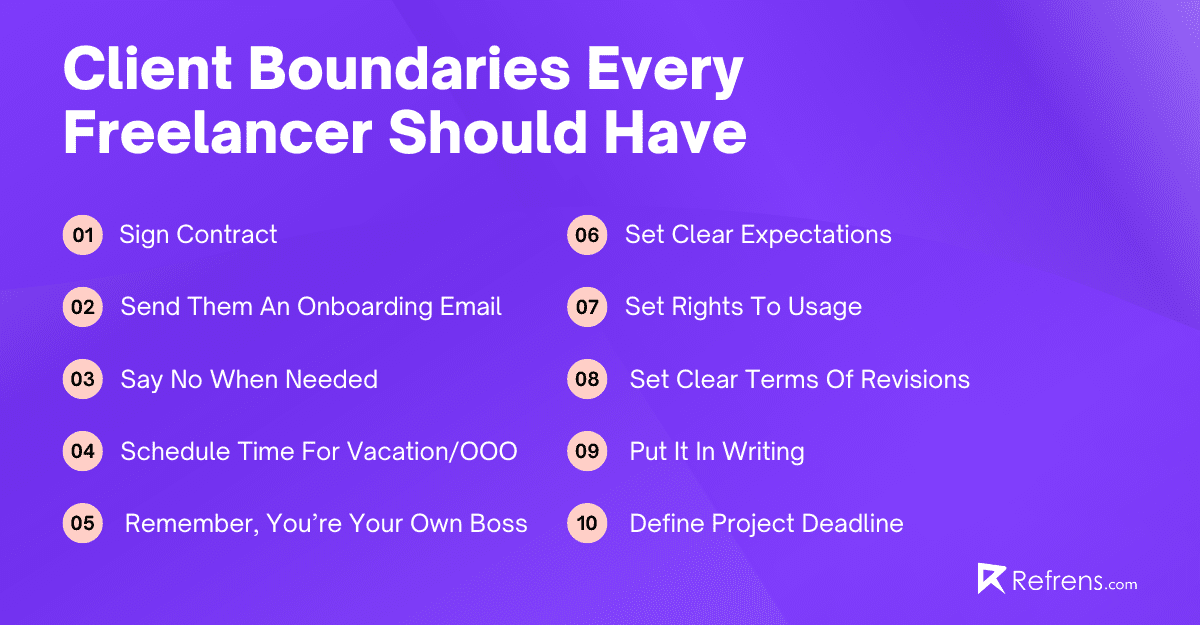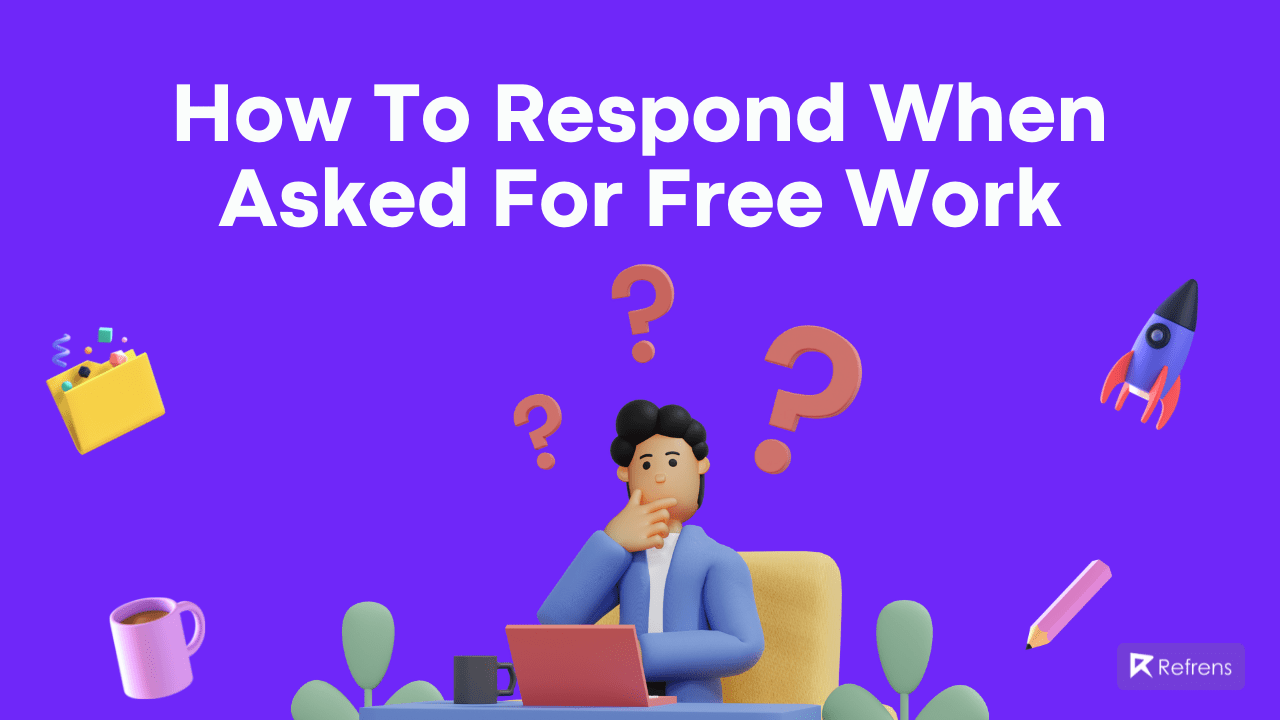“Ding” “Ding” “Ding” “Ding”…
It’s 1 AM, and Rohan’s mobile is constantly buzzing with WhatsApp notifications.
He has recently started freelancing as a website designer. And now his client is messaging him in the wee hours of the night. They need some random font adjustment in the website that Rohan is designing.
While Rohan is busy fixing the website font with a grumpy face, Meena gets a sudden email from her freelance client while vacationing.
The client wants her to write some copies for an upcoming product launch right in the middle of her vacation.
While Rohan and Meena were happy to say goodbye to their corporate jobs and embrace freelancing, no one told them about having client boundaries to protect their time.
Why Is It Important To Set Up Client Boundaries?
A survey done among freelancers suggests that burnout is one of the most common mental health issues among freelancers. And setting up client boundaries at the beginning is critical to help you save from burnout.
A pre-defined boundary is like that guardrail along the edge of the road that protects you from falling. Well-established client boundaries help you:
- protect your time
- from burning out yourself
- achieve a better work-life balance
10 Client Boundaries Every Freelancer Should Have

1. Sign Contract To Avoid Scope Creep
Have you ever signed up for a project, say writing a blog post, but ended up writing social media posts without getting paid for the additional task? Welcome, scope creep! Many new freelancers jump into the project without having a solid contract defining the scope of the work. Result? They do more than they are supposed to do without getting paid for the additional work.
However, you can avoid doing this easily by setting up a contract. Your contract should clearly define the scope of the work, and any additional work will be chargeable. Get it signed and approved by your client before starting the project.
2. Send Them An Onboarding Email
Once you onboard a client, share with them an onboarding email. Use this opportunity to state your working hours, mode of communications, and call times.
For example, you can mention that you work from Monday – to Friday, and your work hours are between 9 AM – 4 PM.
You can address all work-related queries/requests at this time. You should also mention your day-offs like you don’t work over the weekends and so many emails that come on a Saturday evening need to wait till Monday morning for you to respond.
Your onboarding email should also talk about the contact methods and time so that you don’t get bombarded with messages at odd hours.
Setting up such clear rules at the beginning of the work will help you set clear boundaries and have a better work-life balance.
3. Say No When Needed
Every freelancer wants to have a good rapport with the client. And so, most freelancers tend to say yes to everything the client demands. This can hamper not just your mental peace, work boundaries, and scope of work but sets a bad image as a professional.
If you already have a contract in place, and the client is still asking you to do some additional work for ‘free,’ it’s super important to say NO. Or, if you are asked to work on a weekend, although you have mentioned your work hours in the contract, learn to set down your foot.
Saying no, however, is not easy, especially if you’re just starting as a freelancer. However, with time and practice, you will learn it.
4. Schedule Time For Vacation/OOO
Freelancing doesn’t mean you need to hustle 24×7 and carry work wherever you go. Schedule time for breaks and vacation. But also set your boundary for vacation time so that you can enjoy and unwind away from work. Set up boundaries like no receiving calls while your out-of-office message is on.
However, ensure you have communicated about your vacation time to your client well ahead of time and have a clear plan in place so that work is taken care of while you are away.
5. Remember, You’re Your Own Boss
Many clients want freelancers to work like extended team members, and that’s okay. But remember, at the end of the day, you are not an employee but you are your own boss.
So, it’s okay not to agree to sit through all the meetings, especially if you don’t have any direct contribution to that meeting.
If the client requests you to attend all the team meetings, remind them that you’re not an employee and want to skip them.
6. Set Clear Expectations Through Terms And Conditions
Whether working on a one-time or retainer project, you need to set clear weekly and monthly expectations. For example, you can have a day in the week scheduled to discuss the progress of the project. This way, the client won’t budge in your privacy on other days of the week for updates on the project.
7. Set Rights To Usage
As a creator, you need to set clear boundaries with your client regarding the rights and usage of your work. For example, if you have created a design, how are they going to use your work?
So, if you have created a design for a t-shirt, mention that the design is to be used only on t-shirts and not any other merch.
8. Set Clear Terms Of Revisions And Feedback
This one is super important for freelancers. Revisions and feedback can often go down the rabbit hole if you are not setting up your boundaries up front. For example, you worked on a project and closed it. The client comes back to you with revisions after six months.
Are you going to entertain it or treat it as a new project? Or suppose you wrote a case study, the client then wants revision, you did for the first round, perhaps the second round, and then? You can’t keep on doing revisions, right? Having set boundaries will help you close projects faster, get you paid for your work, and save your sanity!
9. Put It In Writing
While setting early boundaries is important, putting those boundaries on writing is necessary. While your client may agree verbally to your boundaries, putting it in writing clarifies things, leaves no scope of guesswork, and makes it transparent.
10. Define Project Deadline
Don’t give in to unrealistic deadlines. Unrealistic deadlines will not only push you to burnout — if you fail to stick to the deadline, it will also tarnish your reputation as a freelancer. Define your project deadline upfront and clearly and use enterprise project management software to make sure you’re on track. It’s wise always to keep some buffer time as a breather.
Tips For Setting Healthy Boundaries
- Set your priorities first.
- Be clear and upfront while communicating your boundaries.
- Put everything in the contract under Terms and Conditions.
- Stick to your boundaries.
- Be open to walking away if need be.
Being a freelancer and your boss is great, but if you don’t protect your time, you will soon be on the way to burnout.
Setting boundaries is a great way to achieve a good work-life balance.
The above-discussed points can help you get started thinking about setting boundaries. However, only you can decide what will work best for your business.
So, take inspiration from here and have your boundaries defined.
Recommended Reads: Best CRM Software with Invoicing
Read more: Top 10 Billing Software For Chartered Accountants
Read more: 15 Best Invoicing Software In 2024
Recommended Reads: Billing Software For Export Business
Author Bio
Chayanika is a freelance writer for B2B Tech and SaaS companies. When she’s not writing, you can find her practicing dance lessons, engrossed in a book, or traveling.


















